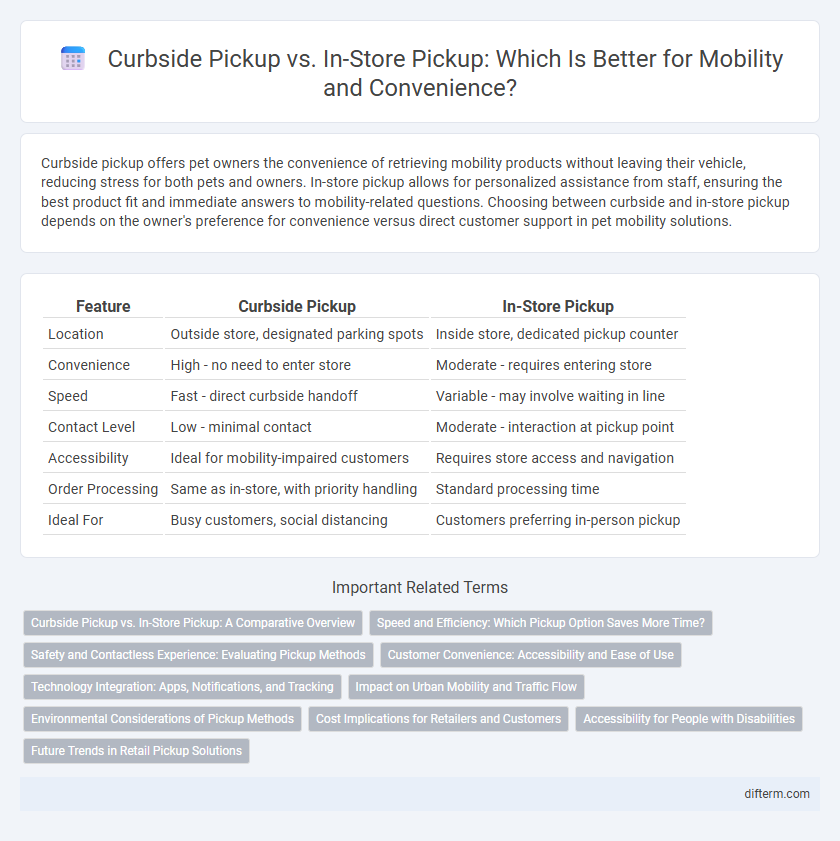Curbside pickup offers pet owners the convenience of retrieving mobility products without leaving their vehicle, reducing stress for both pets and owners. In-store pickup allows for personalized assistance from staff, ensuring the best product fit and immediate answers to mobility-related questions. Choosing between curbside and in-store pickup depends on the owner's preference for convenience versus direct customer support in pet mobility solutions.
Table of Comparison
| Feature | Curbside Pickup | In-Store Pickup |
|---|---|---|
| Location | Outside store, designated parking spots | Inside store, dedicated pickup counter |
| Convenience | High - no need to enter store | Moderate - requires entering store |
| Speed | Fast - direct curbside handoff | Variable - may involve waiting in line |
| Contact Level | Low - minimal contact | Moderate - interaction at pickup point |
| Accessibility | Ideal for mobility-impaired customers | Requires store access and navigation |
| Order Processing | Same as in-store, with priority handling | Standard processing time |
| Ideal For | Busy customers, social distancing | Customers preferring in-person pickup |
Curbside Pickup vs. In-Store Pickup: A Comparative Overview
Curbside pickup offers enhanced convenience by allowing customers to collect orders without leaving their vehicles, reducing wait times and minimizing contact, especially important in urban mobility contexts. In-store pickup provides the advantage of immediate product inspection and potential upselling opportunities, benefiting retailers with physical storefronts. Both methods optimize last-mile delivery efficiency, but curbside pickup increasingly aligns with consumer preferences for seamless, contactless experiences.
Speed and Efficiency: Which Pickup Option Saves More Time?
Curbside pickup significantly reduces wait times by allowing customers to receive orders without leaving their vehicles, streamlining the entire process through seamless app integrations and real-time notifications. In-store pickup often requires navigating store aisles and checkout lines, which can add several minutes to the overall time spent. Data shows curbside services can cut pickup durations by up to 50%, optimizing speed and elevating customer convenience in urban mobility scenarios.
Safety and Contactless Experience: Evaluating Pickup Methods
Curbside pickup minimizes physical contact by allowing customers to receive orders directly at their vehicles, enhancing safety during pandemics and reducing exposure to crowded environments. In-store pickup requires entering the store, which increases the risk of close interactions despite safety measures. Contactless curbside solutions leverage mobile notifications and digital payments, providing a seamless and secure experience compared to traditional in-store methods.
Customer Convenience: Accessibility and Ease of Use
Curbside pickup offers superior convenience by allowing customers to receive orders without leaving their vehicles, reducing wait times and physical effort. In-store pickup requires customers to navigate parking and store layouts, which can be challenging during peak hours or for individuals with mobility issues. Enhanced accessibility through curbside options improves overall customer satisfaction by streamlining the shopping experience and minimizing friction points.
Technology Integration: Apps, Notifications, and Tracking
Curbside pickup leverages advanced mobile apps that provide real-time notifications and live tracking, enhancing customer convenience and reducing wait times. In-store pickup, while supported by apps, often lacks comprehensive tracking features, making curbside technology integration more robust for seamless user experience. Integration of GPS and push notification technologies in curbside systems streamlines order management and improves overall operational efficiency.
Impact on Urban Mobility and Traffic Flow
Curbside pickup reduces vehicle idling time by allowing customers to retrieve orders without entering stores, which decreases congestion in parking lots and main roads. In contrast, in-store pickup often results in additional parking demand and pedestrian activity that can disrupt traffic flow and increase urban congestion. Optimizing curbside infrastructure with designated lanes and real-time communication can further enhance traffic efficiency and urban mobility.
Environmental Considerations of Pickup Methods
Curbside pickup significantly reduces vehicle idling and congestion by allowing customers to remain in their cars, lowering carbon emissions compared to traditional in-store pickup methods. In-store pickup often requires customers to enter the store, potentially increasing energy consumption through extended building operation times and adding to foot traffic-related pollution. Optimizing pickup routes and consolidating orders further enhances the environmental benefits of curbside pickup by minimizing fuel usage and reducing overall greenhouse gas emissions.
Cost Implications for Retailers and Customers
Curbside pickup reduces overhead costs for retailers by minimizing the need for in-store staff and shelf space, while also lowering operational expenses associated with store maintenance. Customers benefit from curbside services through saved time and decreased transportation costs compared to in-store visits. However, retailers may face higher logistical and technology investments to manage curbside systems efficiently, impacting overall profitability.
Accessibility for People with Disabilities
Curbside pickup enhances accessibility for people with disabilities by eliminating the need to navigate through store aisles, reducing physical barriers and exposure to crowds. It provides a convenient and safe option for individuals with mobility challenges, offering direct vehicle-to-store service. In-store pickup may still require assistance or accommodations, but curbside solutions prioritize ease of access and independence for disabled customers.
Future Trends in Retail Pickup Solutions
Future trends in retail pickup solutions emphasize the integration of curbside pickup with advanced mobile apps and real-time GPS tracking to streamline customer convenience and enhance operational efficiency. Retailers are leveraging AI-driven analytics to optimize inventory management and predict demand patterns, enabling faster fulfillment both curbside and in-store. Autonomous delivery vehicles and smart lockers are emerging technologies expected to complement curbside and in-store options, reducing wait times and minimizing human contact.
curbside pickup vs in-store pickup Infographic

 difterm.com
difterm.com